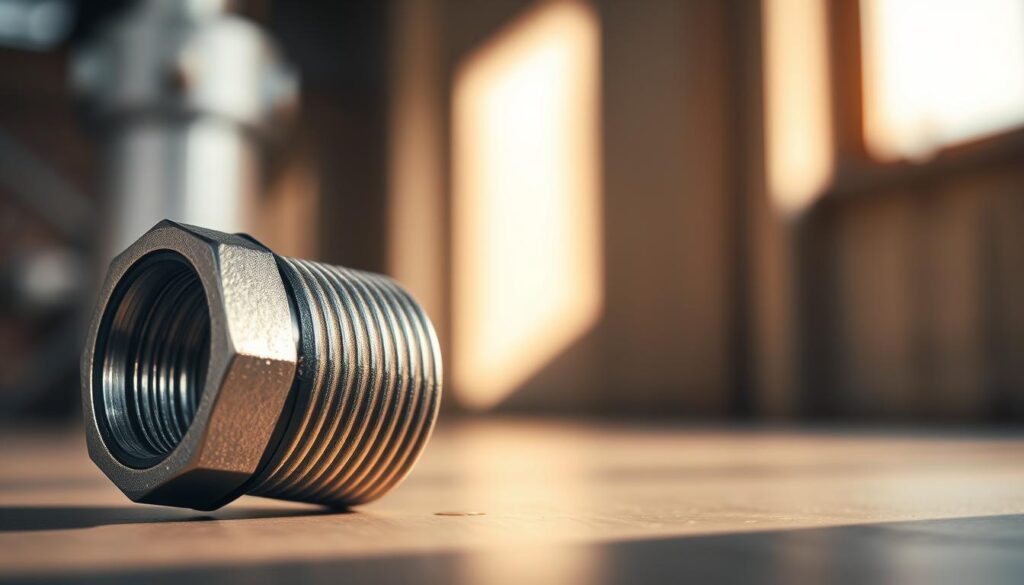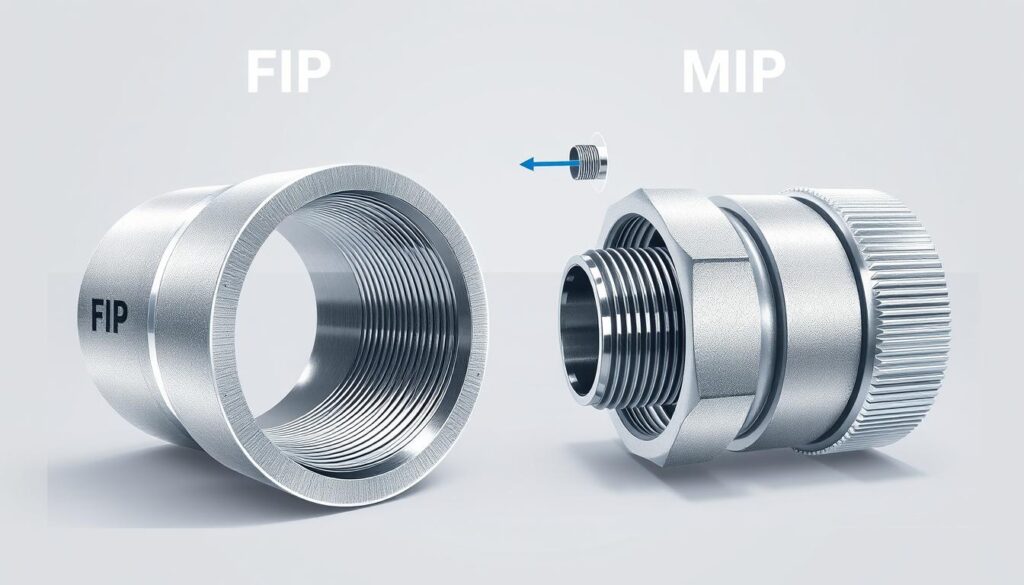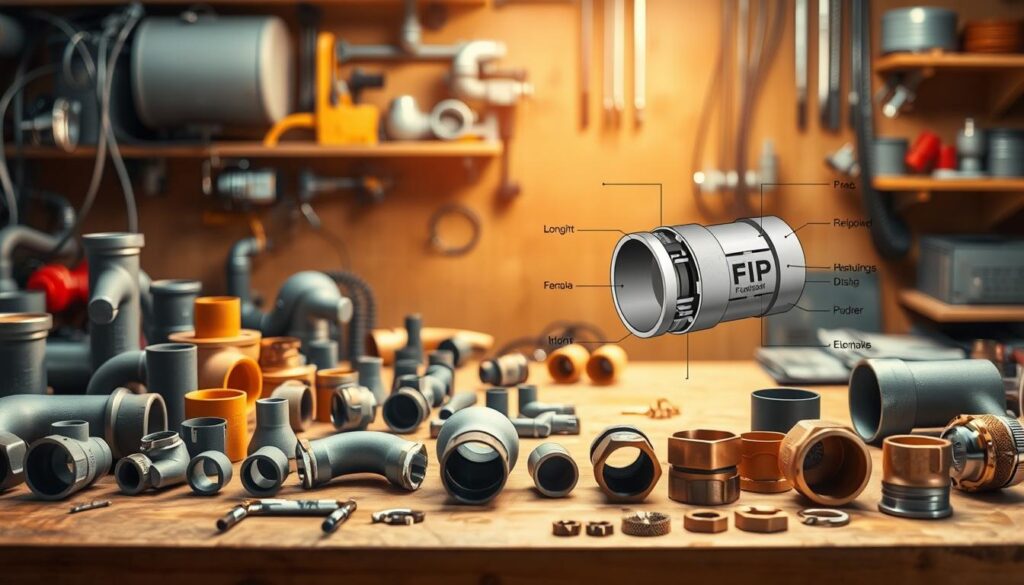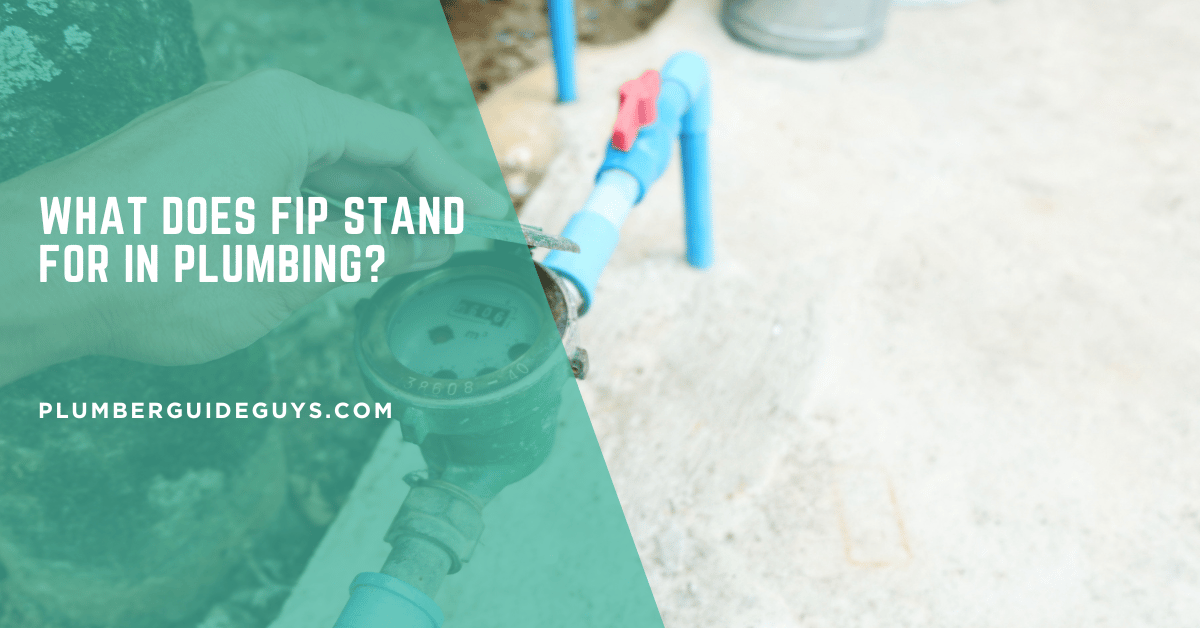Affiliate Disclosure
Plumber Guide Guys is a participant in the Amazon Services LLC Associates Program, an affiliate advertising program designed to provide a means for sites to earn advertising fees by advertising and linking to Amazon.
What Does FIP Stand for in Plumbing? Ever wondered what plumbers mean by FIP? Knowing what FIP stands for can prevent expensive mistakes in home repairs or renovations.

FIP, short for Female Iron Pipe, is key in plumbing. It ensures pipes are securely connected. These fittings have internal threads to hold male-threaded pipes in place. This creates a tight seal for water and gas lines.
Whether you’re a DIY fan or a pro plumber, understanding female iron pipe fittings is vital. It boosts your confidence and precision in plumbing tasks.
Key Takeaways
- FIP stands for Female Iron Pipe
- These fittings have internal threads for connecting pipes
- Used in residential and commercial plumbing systems
- Critical for creating secure pipe connections
- Essential for water and gas line installations
Table of Contents
Understanding Basic Plumbing Terminology
Plumbing can be tough without knowing key terms. Plumbers use special language and abbreviations to work well. It’s important for both pros and DIY fans to know these terms.
Plumbing terms are key for talking in the trade. Knowing the right abbreviations and terms helps a lot in planning and fixing problems.
Common Plumbing Abbreviations Explained
Plumbing abbreviations help pros spot parts and specs fast. Some important ones are:
- FIP: Female Iron Pipe
- MIP: Male Iron Pipe
- NPT: National Pipe Thread
- FPT: Female Pipe Thread
- MPT: Male Pipe Thread
The Importance of Proper Terminology in Plumbing
Using the right plumbing terms avoids mistakes. Precision in language means precise work. A small mix-up can cause big problems.
“In plumbing, every word matters. One wrong term can cost time, money, and potentially compromise the entire project.” – Professional Plumbing Association
Basic Plumbing Standards and Codes
Plumbing terms follow national standards and codes. These rules make plumbing work the same everywhere. They keep plumbing safe and of good quality.
| Abbreviation | Full Term | Common Usage |
|---|---|---|
| FIP | Female Iron Pipe | Internal threaded pipe connections |
| MIP | Male Iron Pipe | External threaded pipe connections |
| NPT | National Pipe Thread | Standard threading specification |
What Does FIP Stand for in Plumbing?
Knowing what FIP means in plumbing is key for anyone dealing with pipe connections. FIP stands for Female Iron Pipe. It’s a type of fitting with internal threads for male-threaded pipes or more fittings.
Plumbers use female iron pipe fittings in homes and businesses. These fittings are vital for making connections between pipes that don’t leak.
- FIP threads are standardized to ensure compatibility
- Used in water supply, drainage, and heating systems
- Available in multiple materials like brass, stainless steel, and PVC
The design of female iron pipe fittings makes them easy to use in plumbing. Plumbers like them for being versatile and reliable. They make connections that can handle different pressures and conditions.
Proper understanding of FIP is essential for successful plumbing installations and repairs.
When picking FIP fittings, think about the material, thread size, and what you need it for. Brass is great for fighting corrosion, while stainless steel is tough in tough places.
The Anatomy of Female Iron Pipe Fittings
Female iron pipe (FIP) fittings are key in plumbing. They connect water and gas systems. These fittings offer a secure connection for various plumbing tasks.
Knowing how FIP fittings work helps in choosing the right plumbing parts. Let’s look at what makes these fittings important in today’s plumbing.
Internal Thread Design and Specifications
The design of FIP fittings is vital for tight connections. They follow standards for compatibility:
- Precise threading with exact pitch and depth
- Consistent internal diameter measurements
- Smooth internal surface to minimize friction
Common Materials Used in FIP Fittings
Plumbing fittings are made from different materials, each with its own benefits:
- Brass: Excellent corrosion resistance
- Stainless Steel: Durable and long-lasting
- Copper: Great for water distribution systems
- PVC: Lightweight and cost-effective
Size Standards and Measurements
FIP fittings come in standard sizes for most plumbing needs:
- 1/4 inch
- 3/8 inch
- 1/2 inch
- 3/4 inch
- 1 inch
Choosing the right size and material is key for a perfect fit in your plumbing.
FIP vs MIP: Understanding the Differences
When you work with threaded pipe connections, it’s important to know the difference between Female Iron Pipe (FIP) and Male Iron Pipe (MIP). These fittings are key to making sure your plumbing works well. They help create tight, leak-free connections in many plumbing systems.

The main difference is in their thread setup. FIP has internal threads, and MIP has external threads. This makes them fit together well in plumbing jobs.
- FIP fittings have threads on the inside of the connection
- MIP fittings have threads on the outside of the connection
- They are designed to create a tight, secure seal when properly connected
To connect FIP and MIP fittings, plumbers use special methods. Plumber’s tape is key to making a watertight seal between these connections.
| Characteristic | Female Iron Pipe (FIP) | Male Iron Pipe (MIP) |
|---|---|---|
| Thread Location | Internal | External |
| Typical Use | Receiving connections | Inserting into connections |
| Sealing Method | Plumber’s tape | Plumber’s tape |
Knowing these differences helps you pick the right parts for your plumbing job. Whether it’s for home water lines or big piping systems, understanding FIP and MIP is essential. It ensures your connections are reliable and leak-free.
Common Applications of FIP in Residential Plumbing
Female threaded fittings are key in home plumbing systems. They help make reliable connections in many areas of the house. Knowing how to use them can help keep your water system running smoothly.
Kitchen and Bathroom Installations
In kitchens and bathrooms, these fittings are a must for water lines. They ensure secure connections for:
- Sink faucets
- Toilet supply lines
- Shower fixtures
- Bathroom vanity connections
Water Heater Connections
Water heaters need FIP connections for both the inlet and outlet. These fittings make sure the connections are tight and leak-free, which is vital for the water heating system.
| Water Heater Connection Type | FIP Fitting Usage |
|---|---|
| Cold Water Inlet | Female threaded fittings create secure connection |
| Hot Water Outlet | Ensures proper water distribution |
| Pressure Relief Valve | Critical safety connection point |
Outdoor Plumbing Systems
Outdoor uses for female threaded fittings include:
- Garden hose connections
- Irrigation system installations
- Exterior faucet attachments
- Drainage system connections
When using plumbing fittings, make sure they fit right and are made of the right materials. This helps avoid leaks and system failures.
How to Properly Install FIP Fittings
Installing threaded pipe connections needs precision and attention to detail. When using plumbing pipe fittings, the right steps can stop leaks and ensure a tight connection.
- Adjustable wrench
- Teflon tape
- Pipe cleaning cloth
- Pipe dope (optional)
Follow these key steps for your installation:
- Clean the threaded pipe connections well
- Wrap Teflon tape clockwise around male threads
- Align threads carefully to avoid cross-threading
- Hand-tighten the connection first
- Use a wrench for the final quarter-turn tightening
When using plumbing pipe fittings, avoid over-tightening. Too much force can harm the threads or crack the fitting. A gentle quarter-turn with a wrench after hand-tightening usually gives the right seal.
| Fitting Type | Recommended Tightening Method | Potential Issues if Incorrect |
|---|---|---|
| Brass FIP | Hand-tight + 1/4 turn | Potential cracking |
| Galvanized Steel | Hand-tight + 1/2 turn | Possible thread stripping |
| PVC FIP | Hand-tight only | Risk of thread damage |
Safety tip: Always wear protective gloves and eye protection when working with plumbing pipe fittings. If you’re unsure about any step, consult a professional plumber.
FIP and NPT Standards: What You Need to Know
Knowing about pipe thread standards is key for good plumbing work. National Pipe Thread (NPT) rules are important for making sure connections work well in different plumbing systems.
NPT connections are the heart of reliable plumbing in the U.S. They make a common language for plumbers and makers. This ensures connections are always consistent and safe.
National Pipe Thread Specifications
NPT threads have special features:
- Tapered design for a tight seal
- 45-degree thread angle
- Standardized pitch and depth
- Works with materials like steel, brass, and plastic
Compatibility and International Standards
NPT is mainly used in the U.S., but knowing international standards is also important. Different places have slightly different thread specs. Always check if they match before you install.
“Precision in pipe thread selection is the key to preventing leaks and ensuring system integrity.” – Plumbing Industry Expert
When using npt connections, it’s vital to match thread types and sizes. This ensures your plumbing system has reliable, leak-free connections.
Troubleshooting Common FIP Connection Issues

Working with female iron pipe (FIP) fittings can be challenging. Knowing common problems helps avoid costly mistakes and water damage.
Leaks, poor sealing, and installation mistakes are common issues. Spotting these problems early can save time and avoid big plumbing headaches.
- Leak Detection: Check for water seepage around threaded pipe connections
- Seal Integrity: Ensure proper application of thread sealant
- Alignment Precision: Verify correct threading before final tightening
When fixing FIP connections, start by checking these areas:
- Thread Condition: Look for signs of damage or wear
- Sealant Application: Verify even and complete coverage
- Tightness: Confirm proper torque without over-tightening
Some common fixes include:
- Replacing damaged thread tape
- Cleaning connection surfaces
- Using appropriate thread sealant
Pro tip: When in doubt, consult a professional plumber to prevent water damage or system failures.
Prevention is key. Regularly check your threaded pipe connections to catch issues early.
Maintaining and Protecting FIP Connections
Keeping your plumbing pipe fittings in good shape is key. It helps your threaded pipe connections last longer and work better. Regular care can also save you from expensive fixes and water damage.
To keep your FIP (Female Iron Pipe) connections safe, you need to act early. Homeowners and experts should use several important maintenance steps. This keeps your plumbing system running smoothly.
Preventing Corrosion and Leaks
Corrosion is a big problem for threaded pipe connections. To fight it, try these steps:
- Apply high-quality thread sealant to stop moisture from getting in
- Use protective coatings on exposed plumbing pipe fittings
- Install dielectric unions in mixed-metal connections
- Watch connections in areas with a lot of moisture
Regular Maintenance Tips
Make a regular maintenance plan to keep your FIP connections in great shape:
- Check threaded pipe connections every three months
- Look for signs of corrosion or wear
- Use the right cleaners to gently clean fittings
- Put on thread sealant when it’s needed
- Swap out worn or damaged fittings right away
Regular maintenance can make your plumbing system last longer and avoid sudden failures.
By sticking to these maintenance tips, you can protect your plumbing pipe fittings. This ensures they work well for many years. Remember, it’s cheaper to prevent problems than to fix them later.
Safety Considerations When Working with FIP
Working with plumbing pipe fittings needs careful safety steps. Keeping yourself and your work area safe is key when dealing with threaded pipe connections.
Before starting any plumbing job, safety comes first. The right protective gear can stop serious injuries when working with FIP fittings.
- Wear safety glasses to protect your eyes from debris
- Use heavy-duty work gloves to shield your hands
- Wear steel-toed boots for foot protection
- Use hearing protection when working with power tools
Professional plumbers say it’s important to follow safety rules when working with threaded pipe connections:
- Inspect all plumbing pipe fittings before installation
- Check for material defects
- Make sure tools fit right
- Follow local building codes
“Safety is not an accident. It’s a systematic approach to protecting yourself and others.” – Safety Professional
It’s also important to know the dangers of different plumbing systems. Gas lines need extra caution compared to water lines.
| Plumbing System | Safety Risk Level | Recommended Precautions |
|---|---|---|
| Water Lines | Low | Standard protective equipment |
| Gas Lines | High | Professional consultation recommended |
| Pressurized Systems | Medium | Pressure relief and careful handling |
If you’re unsure, always ask a licensed pro. Your safety is most important when working with complex plumbing fittings and connections.
Conclusion
Knowing what FIP stands for in plumbing is key for anyone working with pipes. Female Iron Pipe (FIP) fittings are vital for secure plumbing systems in homes and businesses. By learning about FIP fitting connections, you can do better plumbing work.
Knowing plumbing terms is more than just knowing words. It helps you choose the right pipes and how to install them. Whether you’re a pro plumber or like to fix things yourself, knowing this stuff saves time and money. It also helps avoid future problems.
The plumbing world is always changing with new tech and rules. Keeping up with terms like FIP fittings helps you stay current. By always learning and knowing the latest, you’ll be better at handling tough plumbing jobs.
Getting good at plumbing takes both book smarts and hands-on experience. Keep learning, asking questions, and growing your plumbing knowledge. This will help you become more skilled and confident in your work.

